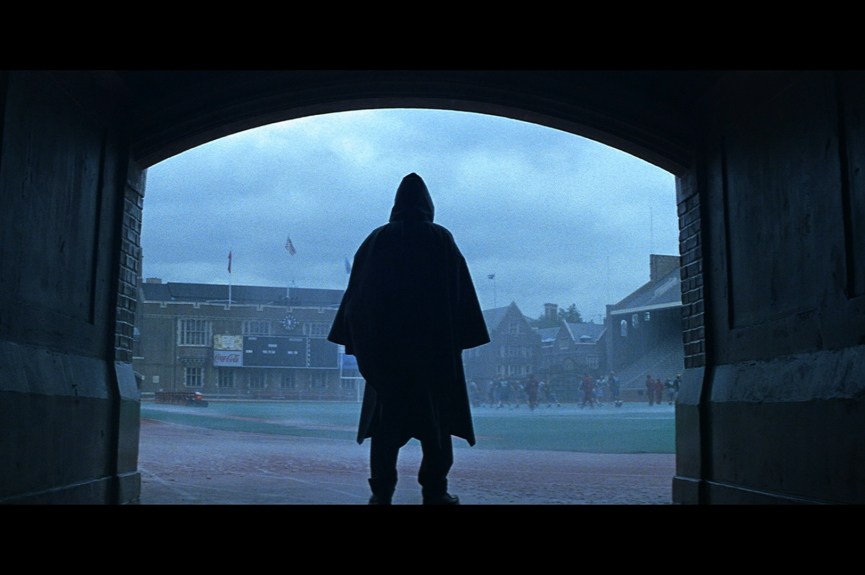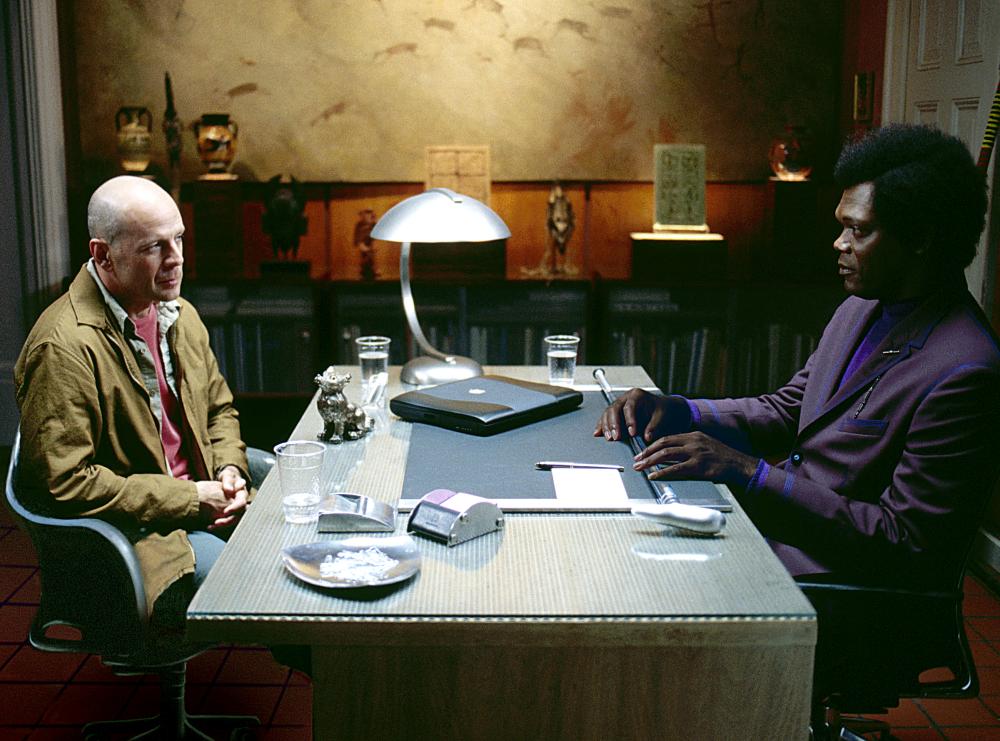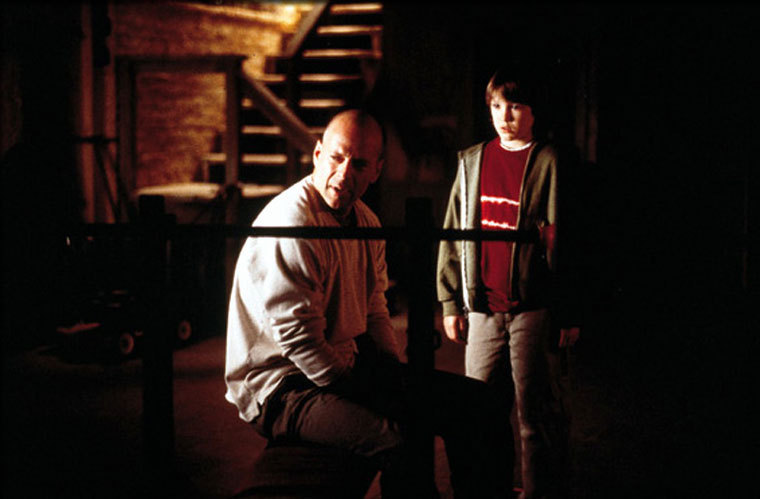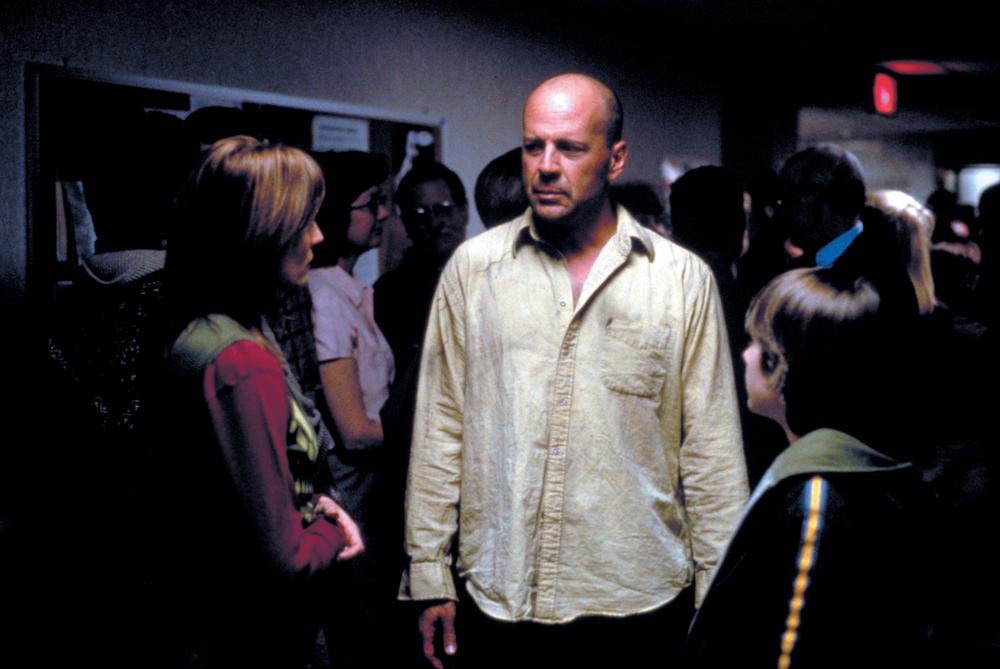4. The brilliant cinematography

The cinematography of Unbreakable is almost unparalleled in comparison to any other comic book or superhero movie. Obviously, The Dark Knight and Nolan’s other Batman movies, shot by the brilliant Wally Pfister, are also in the running. However, Eduardo Serra, the director of photography on Unbreakable, uses long takes so expertly and shoots so many scenes from odd, comic book-like angles, that it stands apart artistically from almost every other superhero film.
Take an early flashback scene, where Samuel L. Jackson’s character, Elijah Price, is a young man, afraid of going outside because he always gets hurt and the kids make fun of him. Serra shoots the beginning of the scene in the reflection of the television screen (reflections are a recurring motif) as Elijah sits, bored and beaten down, in a chair in front of it. It is a slow zoom out, so that we gradually become aware that it is a reflection.
Using the television to both evoke Elijah’s nickname “Mr. Glass,” as well as heighten the sense of his boredom and lethargy with life, is smart. Once Elijah’s mom reveals that she has left a present for him on the bench outside, we see the light coming from outside into the darkly-lit room. The contrast of the backlighting represents the importance of what is out there for him.
As Elijah walks outside to the bench, the audience sees him through the slats in the bench, a comic book-y composition. When Elijah opens the present that his mother has bought for him, which turns out to be his first comic book, it is upside down.
The young man begins to turn it, but instead of the camera waiting for the book to turn around and be right-side up, the camera begins to turn with the book, making it so, when Elijah sees the comic book correctly, the audience still has to wait for another 180 degrees to see it correctly.
The shot represents what a seminal moment it is in the young boy’s life. These comic books will end up being the lens through which he sees the world. Shyamalan and Serra know that they must underscore that point elegantly, and so they do.
Then, to top it all off, as Elijah and his mom look down at the cover of the comic book, the editor and Serra use a match cut to move to a scene where adult Elijah is selling a piece of art that echoes that very comic book cover in the art gallery that he owns.
We can see, both literally and symbolically, that that moment when his mother enticed him to go outside, was one of the most important moments of his life. It is executed better than any action scene in any other superhero film. The themes fed into the choices rather than the technical logistics of a scene dictating the way it had to be shot.
5. The main villain is actually as compelling as the hero

Only The Dark Knight can boast a villain this interesting. Watching Unbreakable, one could almost be persuaded that the movie is more about the villain than the hero. The opening scene of the movie is the birth of the main villain.
In many comic book films, the villain is difficult to identify with because he or she has dastardly plans that offend the audience’s morality. Sometimes they start in a sympathetic place but end up in a horrifying one. The Joker is compelling, not because we necessarily like him, but because he is so unpredictable and played with such verve by Heath Ledger.
In Captain America: Civil War, the somewhat sympathetic villain does not become sympathetic until the concluding scenes. Up until that point, he seemed to be the same type of take-no-prisoners, emotionless “bad guy” viewers had seen countless times before. The surprise of the end made him more complex, especially on future viewings, but did not take away from the cliche feel of his earlier scenes.
In Unbreakable, the villain is a man who dealt with countless hardships in his life. He may be odd, but he is likeable and pitiful and, not only that, he helps our hero unlock his hidden potential. As embodied by Samuel L. Jackson, his strangeness plays as quirky charm. As his vision for David Dunn appears to come crashing down, his sadness is palpable.
The entire focus of his life is dissipating before his eyes. Instead of the audience delighting in his downfall, though, they are feeling the same pain they would if the obvious hero of the film were feeling those same things. Since the movie follows these two men in their parallel journeys, the viewer must care about them both. No other superhero movie has such a relatable villain.
6. The other villain is a real-life criminal

Unlike other superhero movies, where the origin section of the story is just a warm-up for climactic battles of mindless destruction, Unbreakable eschews a bombastic showdown for something more real.
As David Dunn searches for a proper use of his newly discovered “powers,” he (and through his eyes, the audience) is introduced to various terrible crimes committed by the ordinary people walking around him. Having an ability to see what bad things people have done turns out to be much more creepy and atmospheric than any flying man in a costume fighting giant robots or bloodthirsty aliens.
And though David does confront one such devious criminal, it is in a real-life way, which frightens the audience even more. This “bad guy” invaded the home of a family and did terrible things to the parents while holding the children captive. That’s straight out of the nightly news, which is why it sticks in its audience’s minds: it is not something that they can easily dismiss.
7. Its personal subplots are integral to the story, not grafted-on attempts to add manufactured depth

Though other comic book movies have attempted to add aspects of the heroes’ personal lives and allow them to fight within their groups, no movie has utilized those personal aspects more productively than Unbreakable. The second scene of the movie has David removing his wedding ring to flirt with a fellow train passenger. David’s marriage has been in trouble for a very long time and it has affected his relationship with his son.
Those marriage issues and David’s connection with his son are, in some ways, just as important as the overarching plot about David realizing his destiny. His marriage and his skill as a father are directly affected by his life having no true purpose. This is much more effective than the tacked-on marriage plot of Hawkeye in The Avengers: Age of Ultron. Though admirable in what it was attempting to do, it felt like an afterthought specifically designed to add depth for a character that is woefully underused.
Here, David’s personal life is inextricably tied to his life as a potential “superhero.” Shyamalan, as a writer, has given David’s relationships room to breathe. Since the movie does not feel like it is barreling toward a conclusion, it is able to let David’s moments with his wife–outside their room, on a “date” for the first time in years–feel like integral parts of the story.
Therefore, David Dunn is a much more believable hero than viewers are used to in this style of movie. But that is what makes Unbreakable so underrated: there had never been, and there really hasn’t been since, another comic book movie that felt so different and yet fully realized.
Author Bio: Chad Durham is co-editor and contributing writer for RogueAuteurs.com. He also participates bi-monthly in the Rogue Auteurs podcast. His day job is high school English teacher. He has been in love with movies since seeing The Sting when he was 12. The thrill and emotion of seeing a great movie for the first time will always be one of his favorite feelings.